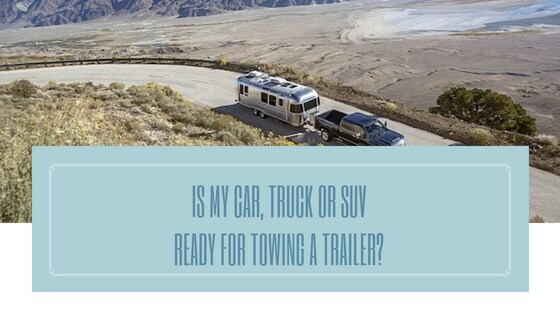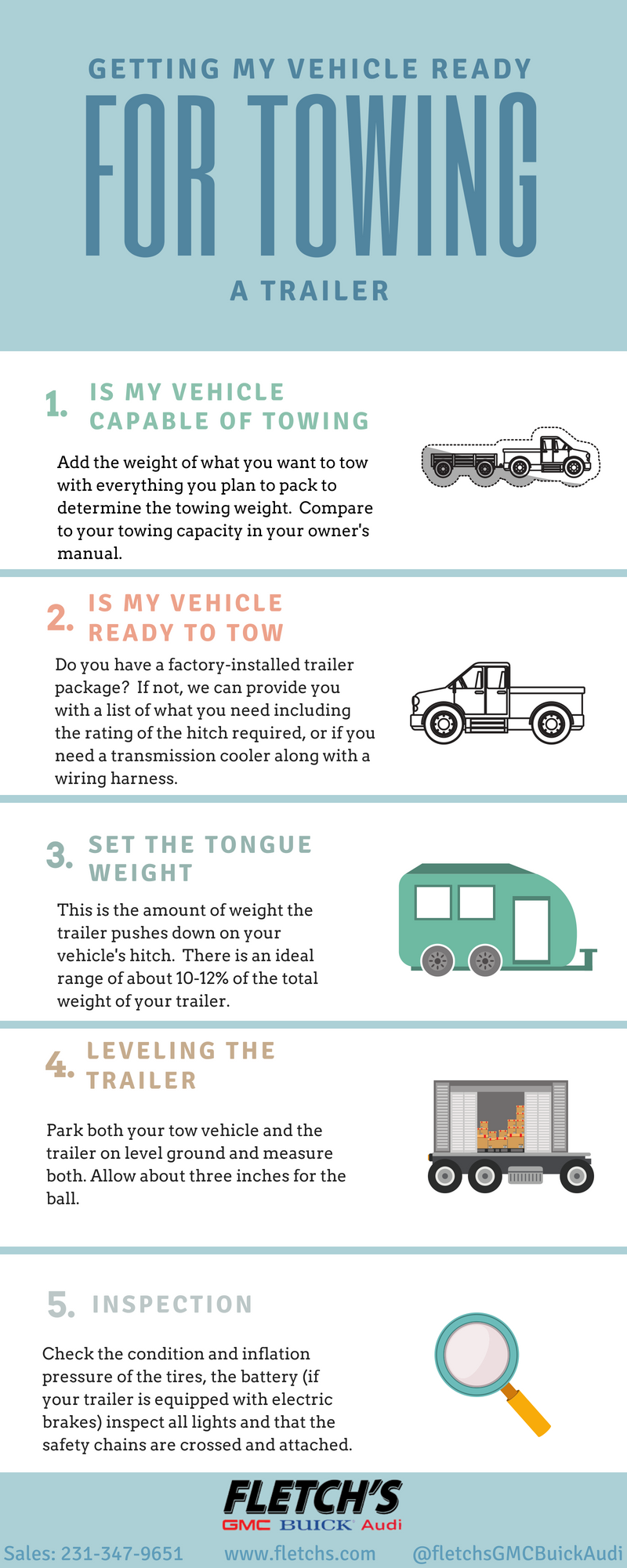
Living in Northern Michigan there are plenty of opportunities to use your car, truck, or SUV for towing, from boats and campers, hauling a car home from college to transporting a car to the city of a recent graduate’s new job. If you’ve not towed before, here’s a checklist you can follow to make certain that your tow is pleasurable, event-free, and doesn’t impact your vehicle’s warranty.
Your first step is to determine if the vehicle you intend to use to tow is capable of pulling the load you have in mind. You’ll need to add the weight of whatever you want to tow to whatever you plan to pack inside it to determine the towing weight. It’s happened more than once that someone has purchased a vehicle to tow a camper based on the camper’s weight alone, not taking into account the hundreds of pounds of water, food, and supplies in the trailer. You can find your vehicle’s towing capacity in the owner’s manual.
If your vehicle is rated to tow the load you have in mind, the next step is to assure that it’s ready to tow. If there’s a factory-installed trailer package on your vehicle, you’re good to go. If not, check with our service department. They can provide you with a list of what the manufacturer includes in its towing package, including the rating of the hitch you’ll require. You may need to add a transmission cooler as well as a hitch and wiring harness. If you don’t match the OEM package it could void the part of your warranty affected.
Once you have your car, truck or SUV sorted, now it’s time to hook the trailer to the tow vehicle. Plan this out in advance and not the morning of your trip, as it could take some time and if not done properly it will diminish your enjoyment of the drive and could even be dangerous.
The first task is to set the tongue weight. That’s the amount of weight the trailer pushes down on your vehicle’s hitch. Too little or too much is bad. There’s an ideal range of about 10% – 12% of the total weight of your trailer. Though it should never exceed the maximum tongue weight rating in your owner’s manual.
Now that you know the target, load the trailer with the equivalent weight that you’ll be hauling. Level the trailer onto a bathroom scale to check the tongue weight. If it’s outside the 10% – 12% range (up or down) move the weight around in your trailer until you achieve the target. If the rated tongue weight is greater than your scale, you can check using a simple lever arrangement for which you can find instructions online.
It’s also important that the loaded trailer be level to the ground when it’s attached to the vehicle so that the trailer remains stable as your drive. You can trim the trailer’s flatness either with an adjustable drawbar or by finding one with the right offset. If you end up using an offset drawbar, make sure it’s rated to handle the trailer weight. Park both your tow vehicle and the trailer on level ground and measure both. Allow about three inches for the ball.
Before heading out there are a few items that need to be addressed. First, is the tow vehicle ready? Towing puts a great deal of stress on a vehicle and it’s important that the engine oil, coolant, tires, and brakes are all inspected and serviced prior to towing. And don’t overload your tow vehicle either.
On your trailer, check the condition and inflation pressure of the tires, the condition of the battery if your trailer is equipped with electric brakes, inspect all lights for proper operation and that the safety chains are crossed and attached. Safety chains should not be taken lightly as they’re your last line of defense so make certain they won’t come loose. You should be ready to go now.
If you plan on towing a car on a dolly, there are a few extra items you need to be aware of. All the same rules about trailering capacity and tongue weight still apply, of course. In addition, you need to be aware of a couple of decisions you may need to make. If the car is front-wheel drive, you can use the dolly without any changes to the car you’re pulling.
If it’s a rear-wheel drive car, the driveshaft will have to be removed by a mechanic. You’ll now have to deal with a six-foot-long greasy steel tube as well. If your tow vehicle can handle the weight of a car trailer this may be the better option. When it comes to AWD or 4WD, it depends upon how the manufacturer configured the system. Some systems allow for the rear axle to freewheel when disconnected, which means it can be loaded like a front-wheel drive car. Others have power going to the rear axle at all times, so you’ll have to disconnect the driveshaft on those vehicles. Check your owner’s manual and if you can’t find a definitive answer you can call the vehicle manufacturer or check in with us.
The company from which you’re renting the dolly can also provide you with lights that attach to your towed vehicle magnetically so you don’t have to cut into the wiring harness. Just make sure you stow them inside the car if you have an overnight stop. If you plan on towing a car on a dolly behind a motorhome, it may be worth the investment to have a standard jack installed in the car to operate the lights.
Follow these straightforward recommendations and you should enjoy trouble-free towing throughout the summer season.
